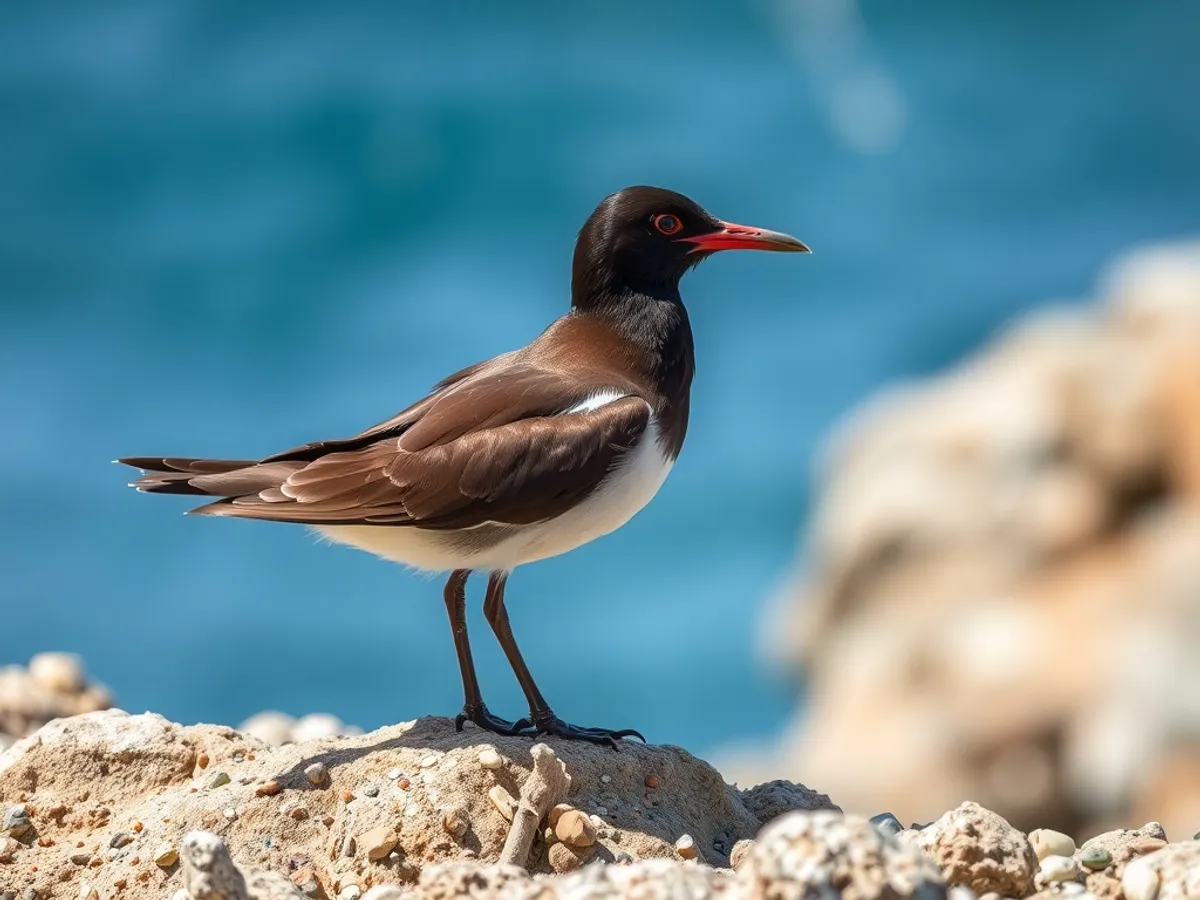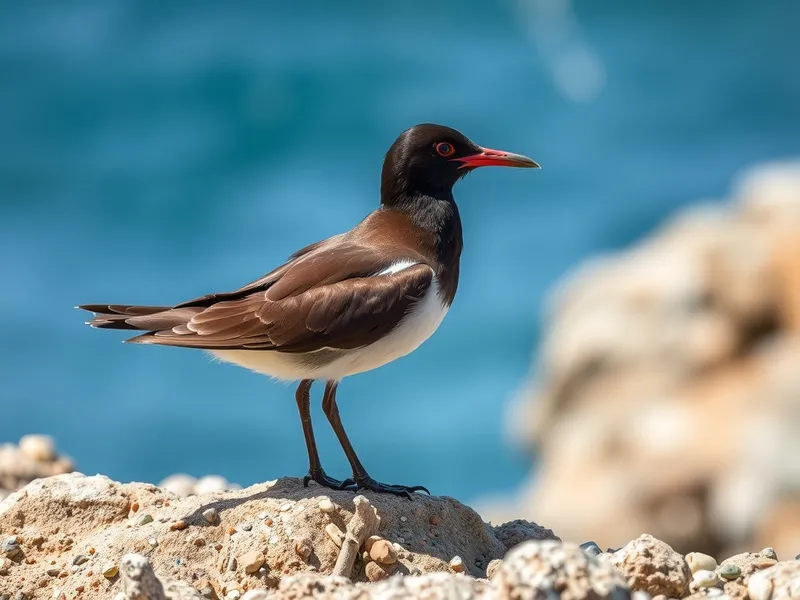
Inca Tern
Larosterna inca

Meet the Inca Tern
The Inca Tern is a striking seabird known for its unique appearance, featuring a slate-gray body, bright red-orange beak and legs, and distinctive white mustachioed facial plumes. It is native to the Pacific coasts of Peru and Chile, where it inhabits rocky shorelines, cliffs, and offshore islands. The Inca Tern is highly agile in flight and skilled at catching fish near the ocean's surface. This bird is gregarious, often seen in large flocks, and is known for its noisy and social behavior. Its unusual plumage and charismatic presence make it one of the most recognizable terns in the world.
Classification
Bird
Habitat
Rocky Pacific coastal regions
Diet
Carnivore
Lifespan
12-14 years
Conservation
Near Threatened
Weight
140-210 grams
📖Fascinating Facts
Fancy Facial Feathers
Both male and female Inca Terns sport bold white mustaches, which are used as visual signals during courtship and social interactions.
Diet of the Sea
The Inca Tern primarily feeds on small fish like anchovies, which are abundant in the cold waters of the Humboldt Current.
Strictly Coastal
This bird rarely strays far from the ocean, nesting and roosting on rocky cliffs, islands, and man-made structures along the coast.
📋Detailed Description
The Inca Tern (Larosterna inca) is a medium-sized seabird, measuring approximately 39–42 cm (15–16.5 in) in length with a wingspan of 64–70 cm (25–28 in). Its plumage is a deep slate-gray, offset by a vivid red-orange bill and legs, and most notably, long, white, curled mustachial plumes extending from the base of the bill across the cheeks—an adaptation unique among terns. The eyes are dark and surrounded by a small white patch, enhancing its striking facial features. The body is streamlined for agile flight, with long, pointed wings and a slightly forked tail, allowing for rapid maneuvers and hovering above water. Inca Terns are highly gregarious, forming dense colonies on rocky cliffs and offshore islands, where they roost and breed communally. Their vocalizations are loud and varied, consisting of harsh, cat-like mews and squawks, which play a role in social interactions and territory defense. They are diurnal, spending daylight hours foraging at sea and returning to colonies at dusk. The species is non-migratory but may disperse locally in response to food availability, especially during El Niño events. Their lifespan in the wild is estimated at 14–15 years, with some individuals living longer in captivity.
💡 Did you know?
The Inca Tern's unique mustache is not just for show—it indicates good health and plays a crucial role in mate attraction.
🔬Research & Sources
Wikipedia Summary
The Inca tern is a near-threatened species of tern in the subfamily Sterninae of the family Laridae. It is found along the Pacific coasts of Chile, Ecuador and Perú, and has appeared as a vagrant in Central America and Hawaii.
Last Modified: 3/3/2025
🎭Behavior & Social Structure
Inca Terns are highly social, often observed in flocks numbering from dozens to several hundred individuals. They exhibit cooperative behaviors such as group foraging and communal roosting. Foraging primarily occurs in the early morning and late afternoon, when schools of small fish, especially anchoveta (Engraulis ringens), are near the surface. The terns employ aerial plunge-diving, hovering briefly before diving headfirst to snatch prey just below the water's surface. They are opportunistic feeders, occasionally taking crustaceans and scavenging scraps from fishing boats. Inca Terns are territorial during the breeding season, defending nest sites with aggressive displays and vocalizations. Outside breeding, they are less territorial and may mix with other seabird species. Preening and mutual grooming are common social behaviors, reinforcing pair bonds and group cohesion.
👶Reproduction & Life Cycle
Breeding occurs mainly from April to July, though timing can vary with food supply and local conditions. Inca Terns are monogamous, forming long-term pair bonds. Courtship involves aerial displays, mutual feeding, and synchronized flights. Nests are simple scrapes or shallow depressions in guano, sand, or rock crevices, often located in dense colonies on inaccessible cliffs or islands. Clutch size is typically 1–2 eggs, which are pale with dark blotches for camouflage. Both parents share incubation duties, which last 23–25 days. After hatching, chicks are semi-precocial, covered in down and able to move within the nest area. Both parents feed the chicks regurgitated fish, and fledging occurs at 35–40 days. Juveniles remain dependent on adults for several weeks post-fledging.
🛡️Adaptations & Survival
The Inca Tern’s distinctive mustachial plumes are thought to play a role in mate selection and social signaling. Their dark plumage provides camouflage against rocky coastal habitats and reduces glare from the ocean. The long, narrow wings and forked tail enable agile flight and precise hovering, crucial for their plunge-diving feeding strategy. Their bills are strong and slightly decurved, ideal for grasping slippery fish. Specialized salt glands above the eyes excrete excess salt, allowing them to drink seawater. Their nesting behavior—using inaccessible cliffs and crevices—reduces predation risk from terrestrial predators.
📚Research Sources
🎨Cultural Significance
The Inca Tern is an iconic species along the coasts of Peru and Chile, often featured in ecotourism and birdwatching literature due to its unique appearance. Its mustachial plumes have inspired local folklore, sometimes symbolizing wisdom or nobility. The species’ name references the Inca Empire, reflecting its restricted range along the former empire’s Pacific coastline. There are no known traditional uses of the bird, but it holds symbolic value as a flagship species for marine conservation in the Humboldt Current ecosystem.
🔬Recent Research & Discoveries
Recent studies have focused on the effects of El Niño events on Inca Tern breeding success and population dynamics, revealing significant reproductive failures during warm-water periods. Ongoing research is examining the genetic diversity of populations across their range, with preliminary results suggesting low genetic differentiation, likely due to high dispersal ability. Satellite tracking and stable isotope analyses have provided insights into foraging ecology and movement patterns. Conservation research is also addressing the impacts of fisheries management on prey availability and the effectiveness of protected areas for breeding colonies.
🎥Wildlife Videos

15 Strangest Birds in the Wild | Unbelievable Avian Wonders | Nature Documentary | Nature Disney
Get ready to be amazed! In this video, we present 15 Strange Birds You Won't Believe Exist — showcasing some of the most ...
Nature Disney

Top 10 Weirdest Birds In the WORLD that you Won't Believe - TTC
In the animal world, birds are, perhaps, the most envied living beings by human. Being able to sail the skies, travel long distances ...
Top 10 Clipz

The World’s Most Unique and Rare Birds Revealed!
Discover the mesmerizing world of rare and unique birds in our latest video! Join us as we delve into diverse habitats—from ...
INSIGHTIFY

Guangdong Nan'ao Series | Episode 4: Black-naped Tern
The Lemen Islands is the core zone of the Nan'ao Provincial Nature Reserve for Migratory Birds. Every summer, the black-naped ...
CGTN Nature

Exotic Birds 4K - Beautiful Bird Sounds In Rainforest | Jungle Sounds | Most Beautiful Birds
Sit back and relax while enjoying this Nature film with real sounds of exotic birds in the rainforest captured on 4K ULTRA HD.
Scenic Scenes Film 4K

The most attractive birds in the world | beauty of nature with calming music 4K video UHD
Birds are some of the most diverse and beautiful animals in the world! Enjoy this 4k Scenic Wildlife film featuring over 130 species ...
Nature Scene's
🌍Habitat Information
The Inca Tern typically inhabits Rocky Pacific coastal regions environments. Inca Terns have adapted to their environments with specialized features and behaviors.
Primary Habitat:
Rocky Pacific coastal regions
More detailed habitat information will be available soon.
🛡️Conservation Status
The Inca Tern is currently classified as Near Threatened. Conservation efforts are crucial for preserving this species for future generations.
Common Threats:
- 🏠Habitat loss and fragmentation
- 🌡️Climate change impacts
- 🎯Hunting and poaching
- 🏭Human-wildlife conflict
⚠️Threats & Conservation Challenges
The primary threats to Inca Terns include overfishing of their main prey, the Peruvian anchoveta, and habitat disturbance from guano extraction and coastal development. El Niño events cause dramatic declines in prey availability, leading to breeding failures and population declines. Human disturbance at breeding colonies, pollution, and introduced predators (such as rats and cats) also pose significant risks. The global population is estimated at 150,000–250,000 mature individuals, with a decreasing trend. Conservation challenges include enforcing sustainable fisheries, protecting breeding sites, and mitigating the impacts of climate variability.
🔬Scientific Classification
Scientific Name
Larosterna inca
Classification Hierarchy
🔍 About Taxonomic Classification
Taxonomic classification is a hierarchical system used by scientists to classify and organize living organisms based on shared characteristics and evolutionary relationships.
The system moves from broad categories (Kingdom) to increasingly specific ones, with each animal's scientific name typically consisting of its Genus and species.
📝Community Notes
Share your observations and insights about the Inca Tern with our community of wildlife enthusiasts.
Join Our Community
Sign in to share your observations and connect with fellow wildlife enthusiasts.
Sign In to ContributeNo community notes yet
Be the first to share your observations about the Inca Tern!
Explore Inca Tern
Select a tab above to learn more about this amazing animal.
📸Photo Gallery
No photos available for this animal yet.
🌟Discover More Wildlife
Continue your journey of discovery with more fascinating animals from our database
